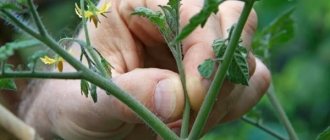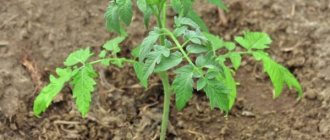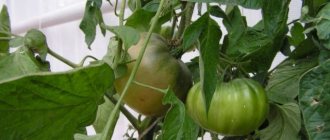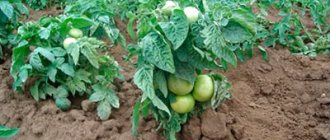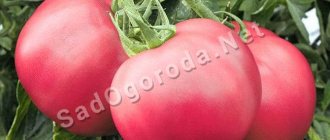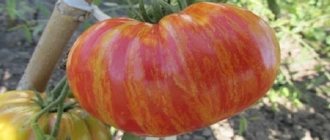Among the huge pink tomatoes, the Raspberry Elephant is in a special place. It fully lives up to its name. Tomatoes reach kilogram weights and often take prizes at exhibitions. Also important highlights are excellent taste, productivity, and simple agricultural technology.
| Height | Landing location | Ripening time | Fruit color | Fruit size | Origin | Fruit shape |
| Tall | Greenhouse, Open ground | Mid-season | Pink | Large | Variety | Flat-round |
Raspberry elephant tomatoes on video
If you grew Raspberry Elephant , please write whether you liked them or not. What was the yield and taste of the fruit under your conditions? Briefly describe the advantages and disadvantages of this tomato in your opinion. If possible, attach to the comment a photo of the entire bush as a whole or individual fruits that you grew. Thank you!
Your reviews of the Raspberry Elephant tomato and additions to the description will help many gardeners evaluate this variety more objectively and decide whether it is worth planting or not.
This is a natural variety of tomato. Therefore, we recommend taking seeds from a ripe fruit and using them for planting in subsequent seasons.
Planting dates and care
From the moment the seeds peck to the first colored fruits, the Pink Elephant will take approximately 112 days. Moving to a permanent place is carried out at 45-55 days of age. By this time, the soil outside should warm up:
- for greenhouses – up to 10° C;
- when grown in the garden - up to 15° C.
You can calculate the exact timing yourself. It is recommended to focus on the long-term weather forecast and climate of the region.
Growing seedlings
The manufacturer advises soaking the seeds in a stimulant before sowing. In addition, they need:
- warm up;
- disinfect;
- soak until it swells.
Sowing is done to a depth of about 1-1.5 cm. The grains are laid out every 1-2 cm in lines, with 4 cm left between them to allow loosening of row spacing.
Seeds are germinated at high temperature (23-25° C) and humidity. After pipping, they are transferred to a cool room with round-the-clock lighting for a week to prevent stretching.
Then the temperature is raised to 20°. Additional lighting is reduced to 12-14 hours. They dive in the phase of 2 true leaves. After growth resumes, feed with a mineral complex with a high nitrogen content. Harden 2 weeks before moving to a permanent place.
Care after transplant
For 1 sq. meter, place 3 bushes if you are going to grow a Pink Elephant into 2 trunks, and 4 when forming one shoot. Tomato:
- water regularly but moderately;
- after extending the second brush, reduce the amount of nitrogen in fertilizers to a minimum, increase the doses of potassium, calcium, phosphorus;
- the soil is mulched.
Formation and rationing
This is an important element of care that makes sense to dwell on separately. The growth of the Pink Elephant bush is usually self-limited after the extension of 8-12 brushes. If this does not happen, the top continues to grow, flowers and ovaries form, which prevents the lower fruits from gaining mass and ripening. To get large, sweet tomatoes, topping should be done after 4-5 grapes or 45 days before the expected end of the season.
At the tips of the bunches, tomatoes do not always set or grow small, and only draw back nutrients. It is recommended to pinch them, leaving 3-4 apples at the base of the bunch.
The larger the tomatoes you want to get, the fewer ovaries there should be on the bush.
The plant will have to be tied and shaped. They lead into 1-2 trunks, the remaining stepsons are regularly removed - the growth power of the Pink Elephant is great, if you miss the moment, it will not only produce long side shoots, but will also have time to put out flower clusters.
That is why the variety is not recommended to be grown in dachas visited on weekends. In a week it will acquire stepsons, which take a lot of strength and nutrients. The leaves require more moisture and actively evaporate it; with irregular watering, the plates curl and can dry out in a hot year. What’s even worse is that the fruits crack, fungal spores get into the wounds, and gardeners remain dissatisfied with their quality, as they complain about in the video:
The leaves under the clusters that have begun to fill are removed. It is also recommended to tie the brushes to a vertical support - they are heavy and creases are possible on the stems.
Features of cultivation
Like many other tomato varieties, “Raspberry Elephant” has its own growing characteristics.
Soil selection and preparation
In order for the tomato to develop successfully, the soil is prepared in the fall. It must be fertilized in advance with compost or manure humus.
Before planting in the ground, seedlings must be hardened off for 2 weeks. To do this, it is taken out into the open air, first for 1-2 hours, and then the time is increased every day.
7-10 days before planting, the beds are watered with hot water and covered with film.
Landing Features
No more than four seedlings per square meter are planted . The distance between them should not exceed 60*40 cm. The sprouts are carefully placed in holes 25 cm deep, removing the lower leaves.
Next, they are sprinkled with earth, lightly compacted and watered. Plants need to be watered abundantly and regularly every 5-7 days. Feeding is done once every 10-15 days. Diluted manure is used as fertilizing - 1 bucket per 100 liters of water.
It is also recommended to mulch the soil with a 5-6 cm layer of rotted sawdust, humus or peat. Mulch protects the soil from drying out, overheating and promotes rapid reproduction of worms beneficial to tomatoes.
How to care for a plant
Due to the fact that the bush reaches 2 meters in length, it needs additional support and garter.
One of the difficulties that arise when growing Raspberry Elephant tomatoes is the variety’s demands on temperature changes. However, if you carry out the procedure of hardening the sprouts before transplanting into the soil, such problems can be avoided.
During the entire ripening period, continuous removal of stepsons is recommended. To normalize the ovaries, 2 shoots are plucked off from them. If you leave them, the tomato bush will begin to branch, which leads to a decrease in fruit.
Diseases and pests
Tomatoes of the “Raspberry Elephant” variety have good immunity to various diseases and pests. The most likely attack on tomatoes of this crop is blossom end rot. To prevent plants from this disease, it is necessary to maintain a balance between nitrogen and calcium in the soil. Nitrogen should be given in moderation, and the calcium content, on the contrary, should be increased.
Apical rot
If the bushes are already affected by this disease, then spraying the plant with a solution of calcium nitrate can help.
Less common, but still relevant for the variety, is brown spot disease. If this disease appears, then you need to reduce watering the plant and ventilate the greenhouse shelters more often.
Brown spot
Harmful insects for “Crimson Elephant” are melon aphids and thrips. Against these pests, gardeners are recommended to purchase the “Bison” product, specially designed to repel insects, in specialized stores.
During the flowering period of the potato crop, tomatoes are often attacked by the Colorado potato beetle. A specially developed drug “Prestige” is also being purchased against it.
Late blight affects those plants that are exposed to excessive moisture. It is necessary to water the holes abundantly, but not often.
Late blight
Advantages and disadvantages of the variety
The main advantages of the Raspberry Elephant variety are:
- great taste;
- beautiful appearance;
- disease resistance;
- high productivity;
- contains a lot of vitamins.
Disadvantages include:
- high sensitivity to soil composition and watering;
- poor resistance to temperature changes.
Despite some shortcomings, the Raspberry Elephant variety attracts many gardeners with its productivity and excellent taste.
Tomato Pink Elephant
The Pink Elephant tomato is one of the relatively new varieties of Russian selection. It was bred at the Moscow breeding and seed company Gisok-agro at the end of the last century. The variety has been listed in the State Register since 1998. Based on the totality of its characteristics, the variety deserves high praise.
Description
The fruits are very large, weighing on average about 300 grams. The more competent the gardener’s actions, the greater the chances of growing kilogram tomatoes. Their shape is flattened, with slightly pronounced ribs, and the skin is painted in an exquisite pink-raspberry color.
The pulp is fleshy, with four or more seed chambers, sugary at the break. The taste is sweet, almost without sourness, with a pleasant aroma. Ripening occurs in the middle period, 115-120 days after emergence. Fruiting is extended, the plants are pleased with the harvest until the cold weather.
The purpose is primarily for fresh consumption. It’s a pity to wrap such luxurious tomatoes, but if you have to, do it in a crushed state: they don’t fit in a container. Keeping quality is not bad, especially if the fruits were picked in a state of blanche ripeness. This allows the bushes to spend energy on pouring the next tomatoes, and the harvest “reaches its condition” in boxes, preferably in a dark place at room temperature.
The variety is semi-determinant, that is, it stops growing on its own, but this can happen at any time, and not just after the first cluster has set. Plants reach a height of 1.2-1.7 meters. Their foliage resembles potato foliage.
| Color | pink |
| Weight | 200-300 g |
| 4,9 / 5 | |
| 2.5-3 kg |
| type | semideterministic |
| 1.2-1.7 m | |
| Term | 120 days |
| above average |
Productivity and cultivation
The yield stated on packets of seeds is from 2.5 to 3 kilograms per bush, but with proper care you can get more.
In the northern regions, the variety is grown in greenhouses and greenhouses, and in the south - in open ground. Brushes usually begin to form above the 7th leaf, and then appear after 2-3 leaves. Resistance to fungal diseases and pests is above average.
Pink elephant tomatoes are propagated by sowing seeds. It is possible to do this by collecting your own seed material from the most prolific bush with delicious vegetables. It is sown in March so that in May the seedlings can be planted in a permanent place.
According to reviews, the bushes grow very spreading; if you plant a single specimen per square meter, it can occupy the entire space. So the name of the variety can be attributed to both the size of the fruit and the dimensions of the plant itself. If the plants are formed into one stem, then they can be planted more densely.
Requirement for care
Productive and hardworking, the Pink Elephant does not allow gardeners to be lazy. The better the care, the higher the return. Plantings should be watered generously, especially during the planting period. Drip irrigation has proven itself well. Loosening the rows and spaces between bushes helps retain moisture in the ground.
It is better to remove the lower leaves so that the plants are ventilated and are not affected by late blight. When a disease occurs, spray with preparations containing copper. To protect against harmful insects, it is often possible to use traditional methods.
Fertilizing begins at the seedling stage, after planting in a separate container, and is carried out twice with complex fertilizers. A mixture of phosphorus and potassium compounds is placed in the planting hole; superphosphate and wood ash are usually used. In the future, mineral and organic fertilizers are used in turn, the latter most often being infusions of mullein or bird droppings.
It is necessary to tie up the stems, and then the heavy brushes, so that the abundant harvest does not break the plants. Regular pinching is a necessary condition for proper cultivation; it is done almost weekly.

